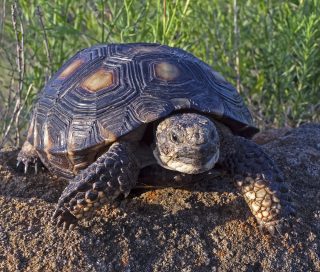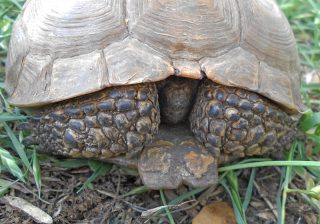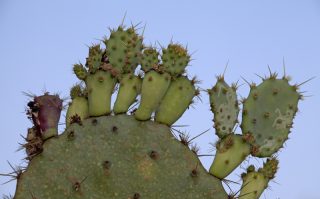
A Texas Tortoise can live 60 years or more. The largest one ever found was 8 ½ inches long from the front of the carapace (top shell) to the back. Robert Benson photo.
10 Jun 2016 – A Noble Beast Is the Texas Tortoise
Every summer I keep an eye out for a very special reptile. I recall the first encounter I had with one several years ago. I was taking an early morning walk around our brush country farm.
Ahead on the trail, I noticed a brown lump. It was about the size and color of a cow patty, but we don’t have cows. As I drew near I could see it was dome-shaped, unlike a flat cow patty.
I began to have an idea what it was. “Cool! I think that is a…” I said and hurried toward it.
About this time the brown lump moved, but very slowly. It had to be a turtle of some kind.
A turtle? Out here on this dry, caliche ridge, sparsely covered with brush? No way. Turtles need water, don’t they?

This female tortoise has pulled her head and front legs in as far as she can. You can see that the gular scute (front part of the bottom shell) is forked and projects forward. In males, the gular scute is much longer. Rival males fight using the gular scute to overturn each other. A defeated male, if he cannot right himself, dies in the heat. Karen Benson photo.
However, it wasn’t exactly a turtle. It was a Texas Tortoise. Tortoises are dry-land members of the turtle family. They are related to the giant, 200-pound tortoises found on the Galapagos Islands. Texas Tortoises are much smaller cousins, but in body shape and behavior they are much like the Galapagos Tortoises.
Both the Texas Tortoise and the Galapagos Tortoise are vegetarians. Neither can pull its entire body back into the protective shell. However, they can get pretty close, and the scaly front legs block the entrance from predators.
I got close up and personal with the tortoise on my trail. I got down on my hands and knees to photograph her. I could tell she was female because the forked gular scute was relatively short. She pivoted away from me. I scampered to the other side to try to photo her with her head extended. I realized that at her size, about 7 inches long, she must be quite mature. In fact, she was probably my age. She and I had a lot in common. Over 60 years of age, a bit banged up, with dark beady eyes, and a definite similarity in the texture of our throat skin! She pivoted away from me again and, I swear, I heard her sigh. The books say they hiss, but this sounded like a sigh to me. The exact same sigh I had uttered often as a teacher. It was the sigh of resigned exasperation. I think we must have had a lot in common!
As she walked off into the brush, I noticed how different her back legs were from her front ones. They are described as “elephantine”. Indeed, the back legs are like stumps that do little more than hold up the back end of the beast.
The front legs are powerful, curved and tipped with long claws. These legs are designed for digging. A Texas Tortoise digs out a small scrape, called a “pallet”, under a prickly pear cactus or bush. The tortoise spends the night, the heat of the day, and most of the winter resting on this pallet. It ventures out to feed on the pads, flowers, and fruit of the prickly pear during the cooler hours of the summer mornings and evenings. In the colder parts of the year, the tortoises hibernate on their pallets, or in slightly deeper excavations. They might come out on milder, sunny days to get a bite to eat.

Prickly pear cactus is bed and breakfast to Texas Tortoises. The fruit, the pads and even the flowers are favored foods. A clump of cactus makes a fine, shady spot for their pallets. Robert Benson photo.
There are four species of tortoises native to North America. All four belong to the genus Gopherus and thus are sometimes called Gopher Tortoises. The smallest tortoise of the four is our own South Texas native, the Texas Tortoise. Its range extends from Tamaulipas, Coahuila, and Nuevo Leon in Mexico north to San Antonio. It simply must have an arid habitat. If taken out of its range, say to the more humid Houston area, a Texas Tortoise will likely die of respiratory illnesses.
In 1977, Texas Tortoises were put on the Threatened List. Without special permits, you are not allowed to take, transport, or possess the tortoise. In fact, you shouldn’t pick one up if you find one. The reason is the frightened creature will likely void its bladder in a last ditch measure to get you to let it go. While this behavior is only a nuisance to you, it can spell death to the tortoise. Tortoises get nearly all the water they need from the plants they eat. They store water in their urinary bladder, and metabolically draw upon this water as needed. Their urine is usually excreted as a thick white paste. If you frighten it into urinating away its water supply, you may condemn it to death by dehydration.
Sadly, I recall the demise of the 60+ years-old female I once found on our farm. A few years after that first meeting with the tortoise, our hunting dog, Axel, scooped her up while out on a run. Axel ran with the tortoise in his jaws all the way to our pond. Standing belly-deep in the pond, he dropped the tortoise. She sank. Helpless in water, she drowned. It was a terrible end for a noble dry-land beast.
As you sweat through another South Texas summer, think of the tortoise napping on its pallet under a clump of cactus. This animal is superbly adapted to the South Texas sun, dryness, sandy caliche soils, and native plants. It cannot survive in subdivisions, public parks, or even in areas cleared of brush for pastures or fields. Do we really need more parking lots and lawns? Let’s try to save some of our natural habitat for the Texas Tortoise, our special brush-country resident.
If you would like to offer comments, please click through to the discussion page
